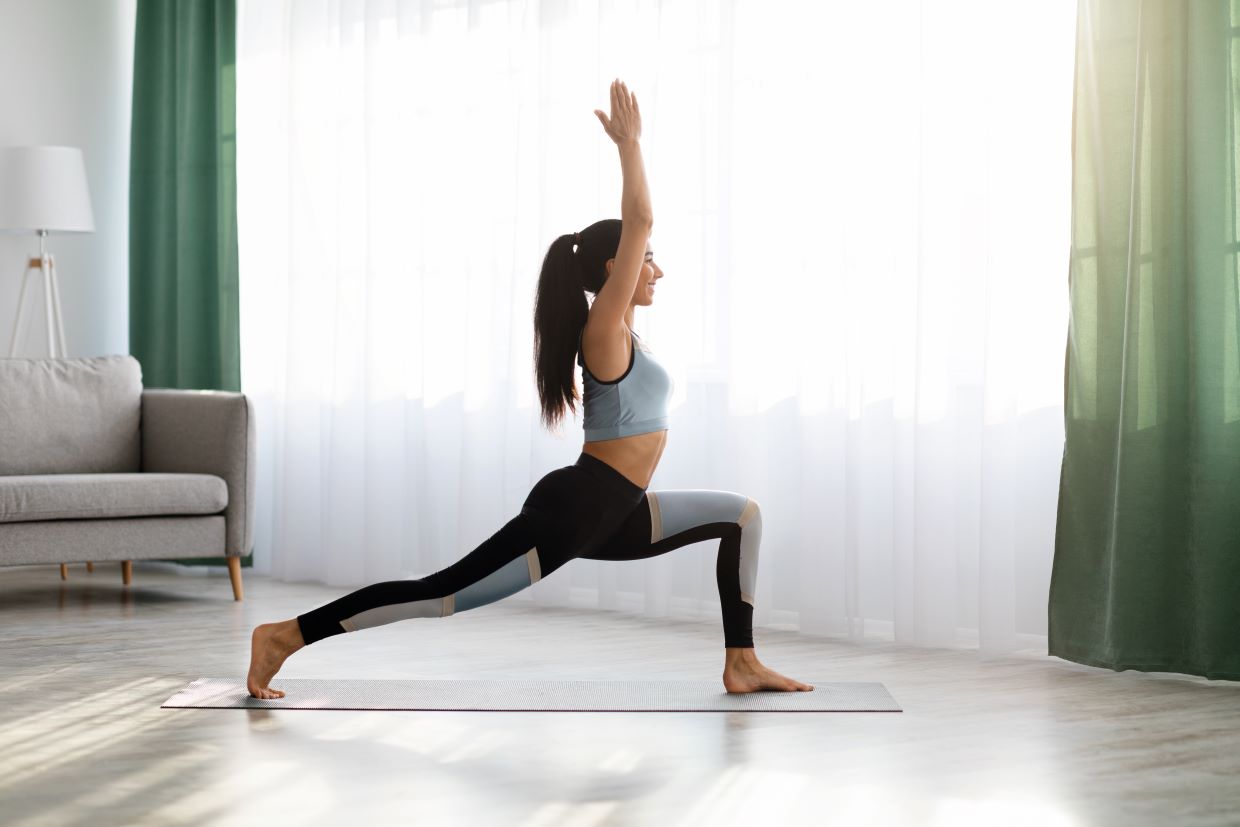Had a recent cold or flu virus? Bounce back to health and fitness with our expert advice on how to return to exercise after having a cold or the flu…
Regular exercise, eating the rainbow, reducing stress… we all know how to support our immunity. Yet, despite our best efforts, we might still fall prey to respiratory infections. Fortunately, you can speed up your recovery and return to exercise safely and effectively after a cold or flu. Here we speak to five experts to discover the best ways to tailor a post-illness recovery plan that will see you back at the gym in no time.
Related: Exercise when sick: can I work out with a cold or flu?
Return to exercise after a cold or flu: is it safe?
Once we succumb to a respiratory virus, thankfully our immune system quickly kicks in. ‘Our innate immune system produces anti-viral proteins called interferons, and mobilises immune cells to engulf and clear infected cells, controlling the initial disease burden,’ explains Dr Ross Walton, cellular immunologist and spokesperson for A.Vogel. ‘This buys us time for our adaptive immune response to create a highly specific, long-lived memory response, mediated by antibodies, which protects us from future infection with the same virus.’
There are also several things you can do to help your body get better quicker. ‘The most effective way of ensuring a speedy recovery from illness is to prioritise your everyday health,’ Dr Walton advises. ‘A broad and varied healthy diet; regular, moderately intense exercise; good sleep patterns, and mental health and wellbeing are all associated with improved immunological fitness, which reduces illness severity and expedites recovery.’
What to eat after a cold or flu:
Cold and flu symptoms aren’t just restricted to your respiratory and muscular systems, but impact your gut, too. ‘Some evidence has shown that respiratory infections can deplete the levels of short-chain fatty acids produced by our gut bacteria,’ says Alex Glover, senior nutritionist for Holland & Barrett.
‘These are important signalling molecules for our immune system and are involved in our body’s immune response. Eating foods such as chicory fibre, kiwis, dates, almonds, beans, legumes, oats, dark-skinned fruits and green vegetables can all support our body in producing the main short-chain fatty acids – butyrate, acetate and propionate.’
You can address post-infection gut imbalances by increasing your intake of plant-based foods. Rather than focusing on 5 A Day, aim to eat at least 30 different plant foods each week, including fermented foods. ‘Eating kefir, kombucha, kimchi and soy products, such as tofu and tempeh, have been shown to promote microbial diversity,’ adds Glover. ‘A broad-spectrum probiotic may also be helpful in the short term to support your microbial diversity.’

Naturopathic tips to support your recovery:
Naturopathy, which addresses the root causes of illness through lifestyle, nutrition, supplements and herbs, also stresses the importance of bolstering your gut microbiome post-illness. ‘Supporting your recovery from illness is often overlooked, but
it is so important,’ says Rhian Stephenson, naturopath and founder of Artah.
‘A recent study revealed that the norovirus can alter our microbiome, and, in this particular study, it took around 58 days for it to return to normal. This means we can be susceptible to further infection, digestive disturbances, or issues with mood and energy for more than eight weeks after infection.’
Along with looking after your gut, Stephenson advises reducing levels of inflammation during and after illness. ‘In the same way that illness can elicit an inflammatory response (such as inflammatory messengers called cytokines), so can the food we eat. Sugar is a prime example of this and has been shown to release cytokines.
Sugar-laden fizzy drinks, ultra-processed foods, fried foods, poor-quality red meat, trans fats, alcohol and highly refined carbohydrates are all considered pro-inflammatory. From a nutrition point of view, you want to focus on eating more coloured vegetables and fruit, good-quality wholefoods and omega-3 fats.’
When should you return to exercise after a cold or flu?
When it comes to training, hold off on exercise while you have symptoms – which can last up to 10 days – then gradually build up your workouts, otherwise your symptoms could return, advises Amanda Place, PT and founder of Sculptrition. ‘Begin with short low-impact cardiovascular workouts of up to 20 minutes, such as walking, yoga, Pilates or swimming, and gradually build the intensity over a couple of weeks. Once you can tolerate this and continue to feel good, you can return to your typical workouts,’ she suggests.
One of the safest ways to wake up muscles after illness is with isometric exercises, performed while the rest of your body is still so you’re not moving through large ranges of motion. ‘Try moving your body into various positions and then squeeze your muscles for 30 seconds. Lie on the floor or sit in a chair and begin to squeeze each of your muscles for 30 seconds, concentrating on muscles in the legs, trunk and upper body. Start with just a few minutes once a day, and build to twice a day.’
When you’re ready to return to your exercise routine, don’t be tempted to overdo it. ‘A good rule of thumb is the 50 per cent rule. Whatever times, weights, sets and reps you were doing prior to getting sick, cut it in half. For example, if you usually perform two sets of squats at 100 pounds, when you return from illness, cut back to one at 50 pounds. If you usually run for 30 minutes, start back with 15 minutes of walking and running intervals.’

How yogic breathing aids cold or flu recovery:
Along with being mindful about exercise and diet, you can also support your journey back to health by priming your body for recovery with yogic breathing.
‘When we are breathing erratically or holding our breath, as we often do with respiratory illnesses, we send signals to the nervous system that something is wrong, so our bodies go into “fight or flight” mode, preparing us to find a way to escape a danger,’ explains Victoria Fox, senior yoga teacher and author of Time to Repair (£14.99). ‘Our immune system is suspended in fight or flight, and, to start the immune system functioning fully, we can change the way we breathe to dial us into “rest and digest”. Here our body can go about repairing and healing, which is key when recovering from illness.’
You can help your body activate the rest and digest mode (aka the parasympathetic nervous system) by practising a full yogic breath, particularly by extending the out-breath. When it comes to postures, ‘focus on poses that open the chest and the sides of the ribs, where the respiratory intercostal muscles are’, says Fox.
‘By putting ourselves into shapes that open the side body [try banana pose or seated side stretch] or open the front of the body in reclining butterfly pose, we help to create space making it easier to breathe. Poses which lift and elevate the chest [think cobra, camel and bridge pose] can also help.’
Read our May issue for an exclusive extract of Time to Repair, by Victoria Fox. Preorder your issue here.
Best supplements to aid recovery after a cold or flu
Calm inflammation and rebalance your microbiome post-infection, with these natural helpers…

Artah Enhanced Probiotic
BUY IT NOW:
£39; artah.co (international shipping available)
This formulation helps your gut recover after illness and antibiotic use, and contributes to a diverse and healthy microbiome.

A.Vogel Echinaforce Drops
BUY IT NOW:
£10.50; hollandandbarrett.com
Research shows echinacea enhances antiviral interferon production and regulates inflammation caused by respiratory infections.

BetterYou D3000+K2 Vitamin D + K2 Oral Spray
BUY IT NOW;
£10.95; betteryou.com
Crucial for optimal performance of killer T-cells in your immune system, vitamin D also reduces inflammation after viral clearance.
Words: Eve Boggenpoel | Photography: Shutterstock







